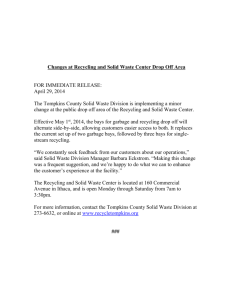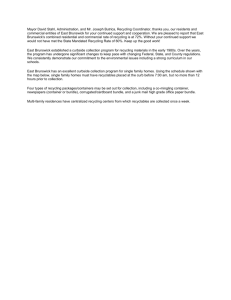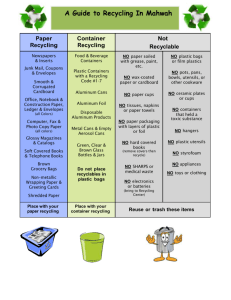FY14 Recycling Plan For WHSAD
advertisement
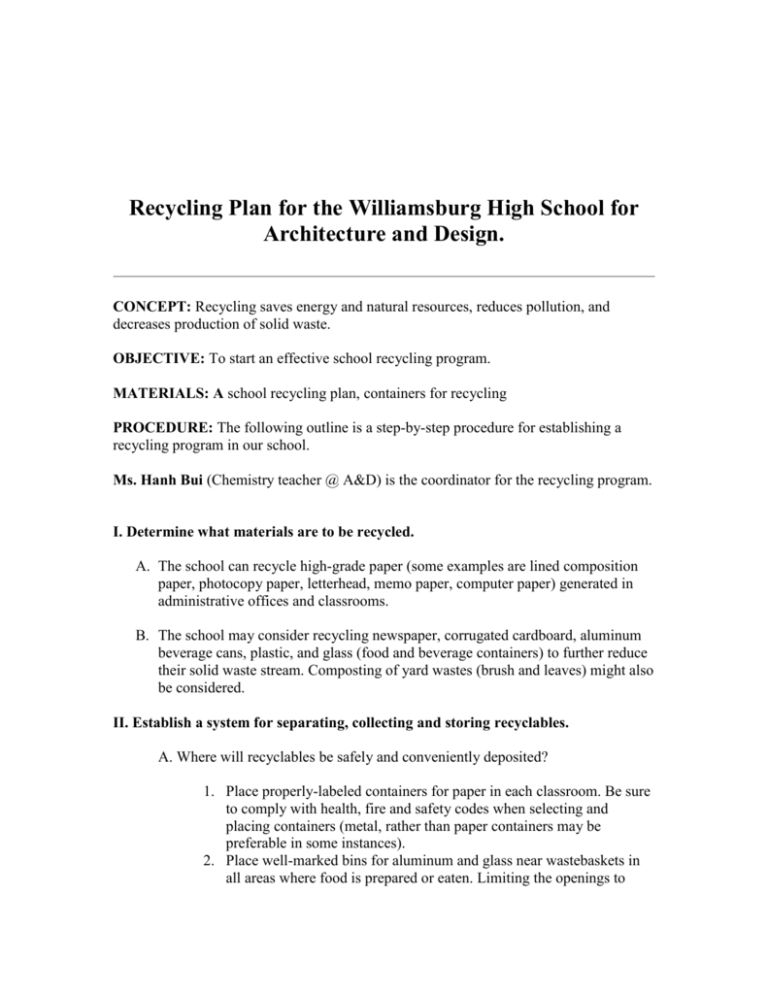
Recycling Plan for the Williamsburg High School for Architecture and Design. CONCEPT: Recycling saves energy and natural resources, reduces pollution, and decreases production of solid waste. OBJECTIVE: To start an effective school recycling program. MATERIALS: A school recycling plan, containers for recycling PROCEDURE: The following outline is a step-by-step procedure for establishing a recycling program in our school. Ms. Hanh Bui (Chemistry teacher @ A&D) is the coordinator for the recycling program. I. Determine what materials are to be recycled. A. The school can recycle high-grade paper (some examples are lined composition paper, photocopy paper, letterhead, memo paper, computer paper) generated in administrative offices and classrooms. B. The school may consider recycling newspaper, corrugated cardboard, aluminum beverage cans, plastic, and glass (food and beverage containers) to further reduce their solid waste stream. Composting of yard wastes (brush and leaves) might also be considered. II. Establish a system for separating, collecting and storing recyclables. A. Where will recyclables be safely and conveniently deposited? 1. Place properly-labeled containers for paper in each classroom. Be sure to comply with health, fire and safety codes when selecting and placing containers (metal, rather than paper containers may be preferable in some instances). 2. Place well-marked bins for aluminum and glass near wastebaskets in all areas where food is prepared or eaten. Limiting the openings to recycling containers often helps to alert users that they are not garbage receptacle (i.e. a small hole for cans and bottles). 3. Designate an area for flattening, bundling and storing corrugated cardboard and storing newspaper. B. Who will collect recyclables? How frequently will the collection occur and what equipment will be necessary? 1. Custodians can collect material throughout the school facilities every Friday afternoon by placing each type of recyclable material in a special garbage can, bin or hamper. 2. Custodians can then take recyclables to a designated storage area on the school grounds (within a school building proper, in a shed, in a roll-off container or dumpster) until they can be marketed. III. Educate the school community about the program. A. Send a memo detailing the program to administrators, teachers, and staff. B. Schedule time to explain the program. The education can be done by students, teachers, administrators, or recycling coordinators. Sometimes, the message is better received when delivered by students. 1. Explain the necessity for recycling in the school by referring to the state recycling law, environmental needs, and the fact that we are throwing away valuable resources. 2. Explain how the program will work, including the following: i. Show samples of the materials to be recycled. ii. Explain the importance of keeping recycling containers free of contaminants (e.g., chewing gum, food waste, paper napkins/towels/tissues, waxed paper, aluminum foil, plastics, and paper clips.) Note: Staples are generally not considered a contaminant. iii. Explain where the various recyclables should be deposited within each room and when they will be collected from individual rooms. iv. Let people know who the program coordinator is so he or she can assist and be notified if there are any problems. 3. Display recycling poster and set up displays in prominent locations in the school building. 4. Include general information about the program in school notice and newsletters which are taken home or are mailed to the student's parents. 5. To unify the program and to heighten its visibility, use the standard recycling symbol or a recycling slogan or mascot in all recycling publicity and on all recycling containers. Consider sponsoring a contest to acquire a suitable slogan or mascot, or ask the art teacher if students may design a poster and decorate storage containers during art classes. 6. Develop a form which can be appropriately filled out and given to anyone whose recyclables are contaminated with unacceptable material or whose regular garbage contains recyclables. Setting good examples for youth to follow is an important task for the schools. If children develop the recycling habit in school, they will probably practice recycling at home and elsewhere in the community; thus the school should be proud of its efforts to "give its trash a second chance."

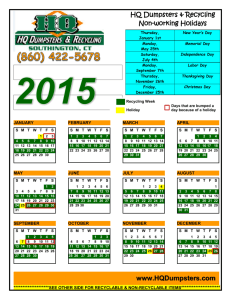
![School [recycling, compost, or waste reduction] case study](http://s3.studylib.net/store/data/005898792_1-08f8f34cac7a57869e865e0c3646f10a-300x300.png)

